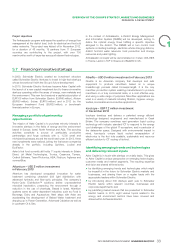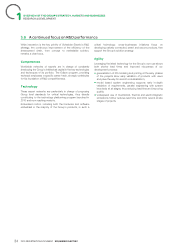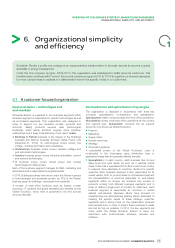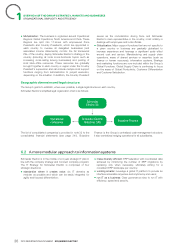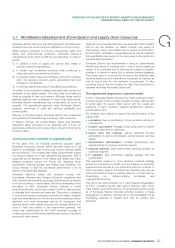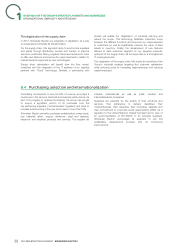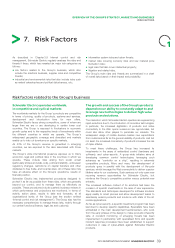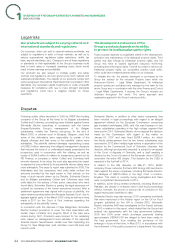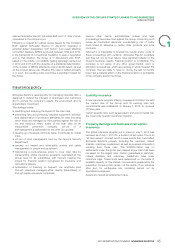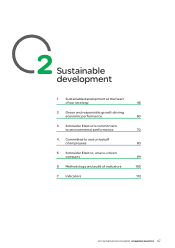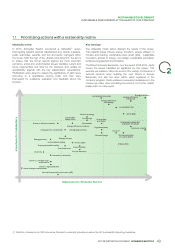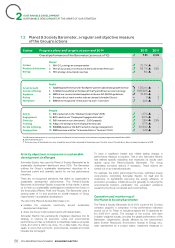APC 2013 Annual Report Download - page 42
Download and view the complete annual report
Please find page 42 of the 2013 APC annual report below. You can navigate through the pages in the report by either clicking on the pages listed below, or by using the keyword search tool below to find specific information within the annual report.
1OVERVIEW OF THE GROUP'S STRATEGY, MARKETS AND BUSINESSES
RISK FACTORS
The market for software based solutions has significantly faster existing line-up or enter a new segment. There are a number of
cycles than Schneider Electric’s traditional markets. As a different integration scenarios, ranging from total integration to
provider of critical infrastructure management solutions, the separate organization. An integration plan is drawn up for each
Group nevertheless cannot compromise on its standards of acquisition and submitted to the Acquisitions Committee for
outstanding reliability and security of its solutions. As a approval. The plan is implemented by an integration manager
consequence, a program is underway to generalize the latest who reports to a Steering Committee that initially meets at
standards of system engineering, allowing different teams to monthly intervals and then on a quarterly basis.
work in parallel on complex products or systems, while assuring The unit that presents the acquisition project is accountable to
the highest quality standards. Coupled with such techniques as the Group’s senior management for meeting clearly defined
early prototyping, leveraging 3D printing, and simulation, these business plan targets covering future performance and expected
efforts contribute to the continued reduction of go-to-market synergies. Actual performance is measured against business
lead times. plan targets during quarterly business reviews and, for the largest
To sustainably manage these challenges, the Group needs to acquisitions, by the board of directors.
constantly invest into the competencies of its 12,000 R&D Value in use is determined by discounting estimated future cash
engineers, both to reinforce its traditional expertise and develop flows that will be generated by the tested assets, generally over a
new domains. Worldwide competence networks, which extend period of not more than five years. These future cash flows are
into universities, research centers and partners then remain the based on Group management’s economic assumptions and
backbone of Schneider Electric’s R&D organization. Each operating forecasts. The discount rate corresponds to Schneider
network constantly monitors merging technologies and Electric’s weighted average cost of capital (WACC) at the
competitive trends in its domain, decides the launch of research valuation date plus a risk premium depending on the region in
efforts to position the Group ahead of those trends and ensure question (local risk-free rate), the nature of the target’s business
the related upgrade of the network’s talent pool. (appropriate beta), and the structure of the financing (taking into
Schneider Electric’s strategy involves growth
account the debt to equity ratio and risk premium on the debt).
The Group’s WACC stood at 7.8% at December31, 2013,
slightly higher compared to the 2012 financial year. The
through acquisitions and mergers that perpetuity growth rate was 2%, unchanged on the previous
arepotentially difficult to execute financial year.
Goodwill is allocated to a Cash Generating Unit (CGU) when
The Group’s strategy involves strengthening its positions through
initially recognized. The CGU allocation is done on the same
acquisitions, strategic alliances, joint ventures and mergers.
basis as used by Group management to monitor operations and
Changes in the scope of consolidation during2013 are described
assess synergies deriving from acquisitions. Impairment tests are
in note2 to the consolidated financial statements (Chapter5).
performed at the level of the cash generating unit in2013 (CGU),
External growth projects are examined in detail by the i.e the Partner, Infrastructure, Industry, IT, Buildings and CST
businesses and corporate functions (strategy, finance, legal businesses. Details on asset impairment are provided in
affairs, tax and human resources) concerned, under a rigorous note1.11 to the consolidated financial statements (Chapter5).
internal process developed and led at Group level. A launch Where the recoverable amount of an asset or CGU is lower than
committee is responsible for initiating the review process to its book value, an impairment loss is recognized. Where the
identify the risks and opportunities associated with each external tested CGU comprises goodwill, any impairment losses are firstly
growth project, while a number of validation committees review deducted therefrom.
the results on an ongoing basis. Projects that successfully come
The Group’s success depends on its ability to
through the review process are submitted for approval to the
Group Acquisitions Committee made up of the main members of
senior management. The largest projects require the prior attract and retain qualified individuals, and
approval of the Chairman and CEO, and, in some cases, the developing a workforce for the future
board of directors.
External growth transactions are inherently risky because of the
Competition for highly qualified management and technical
difficulties that may arise in integrating people, operations,
personnel is intense in the Group’s industry. Future success
technologies and products, and the related acquisition,
depends in part on the Group’s ability to hire, assimilate and retain
administrative and other costs.
engineers, sales people and other qualified personnel, especially in
the area of energy efficiency solutions. This ability can only result
This is why an integration procedure for new acquisitions has
from a strong employee-centric human resources strategy. Equally
been drawn up. The integration of acquisitions is a process that
important is the Group’s ability to prepare its workforce for the
extends over a period of six to 24months depending on the type
future through learning and identifying talent within the
and size of the newly acquired company. The integration
organization.
scenario for each acquisition varies depending on whether the
business was acquired to strengthen or extend the Group’s
40 2013 REGISTRATION DOCUMENT SCHNEIDER ELECTRIC





